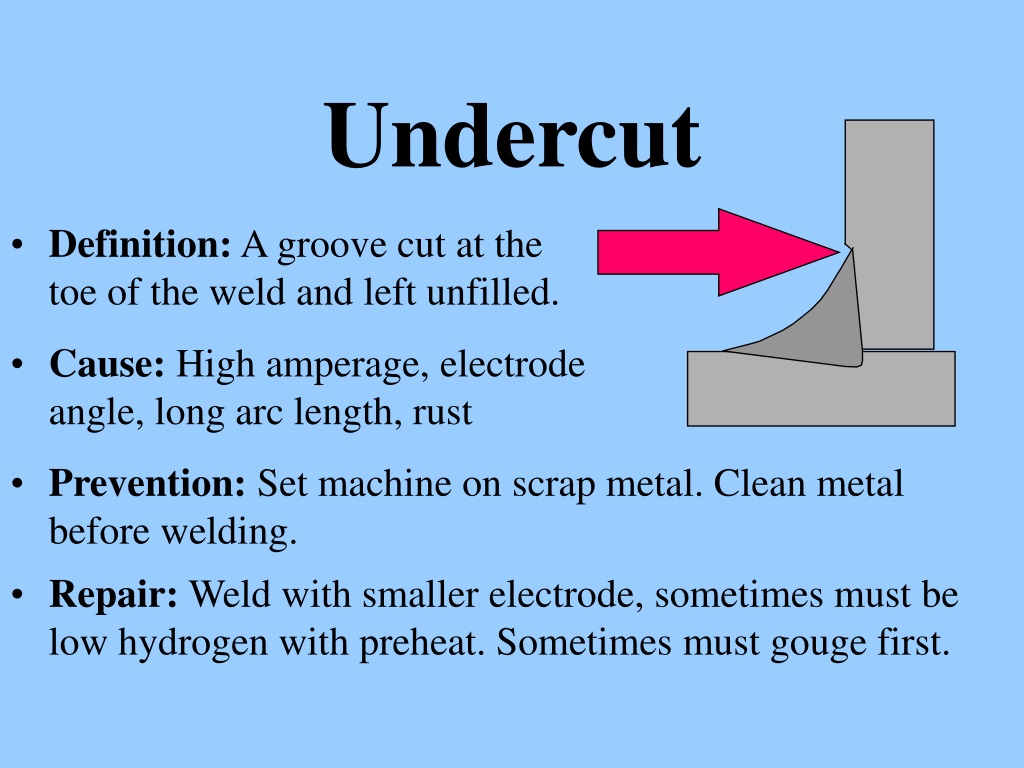Ideal Practices for Preventing Weld Undercut: Understanding the Essentials
Ideal Practices for Preventing Weld Undercut: Understanding the Essentials
Blog Article
Vital Tips for Welders: Avoiding Undercut Welding and Ensuring Stronger Weld Joints
In the world of welding, accomplishing sturdy and solid weld joints is the cornerstone of generating top quality work. One usual challenge that welders typically run into is undercut welding, which can compromise the honesty of the weld joint.

Recognizing Undercut Welding
Undercut welding is a common welding issue that takes place when the weld metal fails to effectively load the groove and causes a groove-like depression along the weld grain. This issue deteriorates the weld joint, making it vulnerable to cracking and failing under stress and anxiety. Damaging can be brought on by various factors, including extreme welding existing, high welding rate, improper electrode angle, inaccurate electrode dimension, and inadequate welding method.
One of the main factors for undercut welding is a discrepancy between the welding present and the welding speed. If the welding current is too expensive or the welding speed is also fast, the weld steel might not effectively fill up the groove, causing undercutting. In addition, using an electrode that is too huge can lead to a similar end result, as the excess metal can not effectively move into the groove.
To prevent undercut welding, welders need to guarantee they are using the right welding parameters, maintain an appropriate electrode angle, select the suitable electrode dimension, and practice proper welding methods. By addressing these factors, welders can reduce the danger of undercutting and develop stronger, more reliable weld joints.
Proper Welding Method
Efficient welding strategy plays an important role in ensuring the high quality and honesty of weld joints. One essential facet of proper welding strategy is keeping the correct angle and range between the welding weapon and the workpiece.
In addition, a consistent and steady hand motion is crucial for producing solid and long lasting weld joints. Welders need to aim for smooth, consistent movements to guarantee even distribution of the weld product. Appropriate control of the welding gun and filler material is likewise essential to attaining ideal penetration and combination.
In addition, regulating the warmth input and choosing the suitable welding parameters based upon the material being welded are important consider accomplishing premium welds - Preventing weld undercut. Welders should comply with the suggested settings supplied by welding treatment specifications and change them as required based upon the particular requirements of the job. By understanding correct welding methods, welders can considerably improve the strength and reliability of their weld joints
Choosing the Right Electrode
When thinking about the importance of selecting the ideal electrode in welding applications,Preserving the appropriate angle and distance in between the welding weapon and the workpiece is basic. The option of electrode plays a vital role in figuring out the top quality and stamina of the weld joint. Electrodes come in different types, each designed for certain objectives and products.
To start with, selecting the proper electrode diameter is necessary. Thinner electrodes appropriate for welding thin products, while thicker electrodes are much better for thicker materials and higher warm applications. Matching the electrode size to the thickness of the workpiece helps attain a well balanced weld.
Secondly, comprehending the product make-up of the electrode is vital. Different electrodes are made for welding certain products like steel, stainless steel, aluminum, or cast iron. Making use of the proper electrode product guarantees good blend and lessens the danger of defects in the weld.
Last but not least, taking into read this consideration the welding setting and method is vital when selecting the electrode kind. For circumstances, particular electrodes are better fit for upright or overhead welding placements, while others work well for flat or straight placements. Picking the right electrode based upon the welding strategy boosts the total weld quality and stability.
Preparing the Base Metal
To ensure an effective welding procedure, what initial actions should be taken when preparing the base steel for welding? Furthermore, any type of existing weld material or residue from previous welding should be eliminated to make certain a clean surface area for the brand-new weld.

Performing Post-Weld Inspections

After carrying out these analyses, welders have to contrast the outcomes against industry criteria and job requirements to guarantee that the weld joint satisfies all required standards. Any type of discrepancies or inadequacies found during the post-weld assessment must be promptly addressed through ideal rehabilitative procedures to ensure the weld's stability. By vigilantly performing post-weld evaluations visit the website and immediately addressing any concerns, welders can support the top quality and dependability of their work, inevitably adding to the safety and security and longevity of the bonded frameworks.
Verdict

To conclude, avoiding undercut welding and making sure more powerful weld joints require a combination of proper welding method, selecting the appropriate electrode, preparing the base metal correctly, and carrying out post-weld evaluations. By comprehending the reasons for undercut welding and carrying out the needed preventative measures, welders can produce top quality weld joints that meet sector standards and ensure the architectural integrity of the welded components.
Undercut welding is a typical welding flaw that takes place when the weld metal stops working to appropriately fill the groove try this out and results in a groove-like clinical depression along the weld bead (Preventing weld undercut). Undercutting can be caused by different variables, including excessive welding existing, high welding rate, improper electrode angle, inaccurate electrode dimension, and bad welding technique
One of the primary factors for undercut welding is a discrepancy in between the welding current and the welding rate. If the welding current is too high or the welding speed is as well fast, the weld steel might not effectively fill up the groove, leading to undercutting.Keeping the right angle and distance between the welding weapon and the work surface is basic when considering the relevance of picking the ideal electrode in welding applications.
Report this page